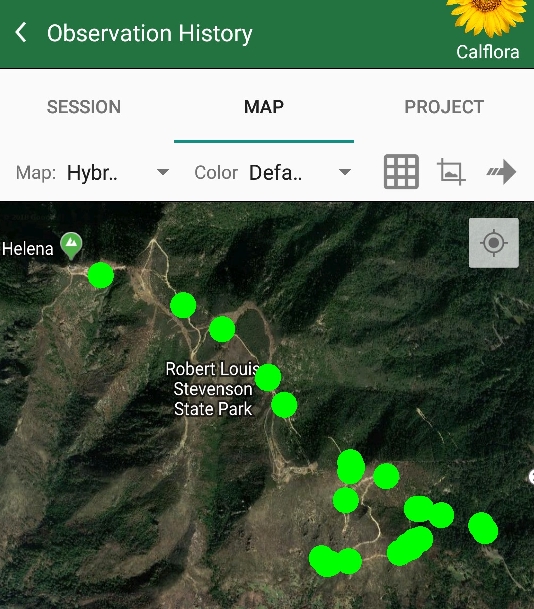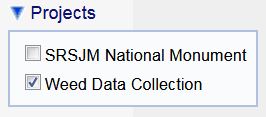| |||||
|
Updated September 14, 2022
Use the
My Calflora
page to customize your experience of the Calflora website
and the Calflora phone applications.
If you are not yet registered, press
|
|
||||
| Contributor Profile | |||||
|
Open this tab to enter biographic information about yourself -- anything that
you want other Calflora users to know, such as your particular botanical interests.
|
|||||
| Groups | |||||
|
Open this tab to join a group, or to check on the recent activity
(new observations) of any groups of which you are a member.
Press
Press
For each group, open
|
|||||
| Comments | |||||
|
You can comment on any observation record in Calflora.
Informed comments can be a helpful source of feedback for the person responsible for an observation.
Open this tab to look up comments you have made about other contributors' observations, or comments that others have made about your observations. |
|||||
| Preferences | |||||
|
Center Point
Specify your personal center point.
This becomes the starting point for various applications, including Plant Observation Entry, My Observations, and Observation Search.
Email Notifications on Group Activity and Comments
You can ask to be notified by email when there is new activity in one of your groups, or when there are comments on your observations.
The timing is as follows.
Using Observer Pro as an Independent Historical Records from saved searches If you are using Observer Pro as an Independent, you can arrange to load your own sets of historical records into the phone app, one set of records per project. This can be useful if, for instance, you want to check on the well being of a plant population you observed previously, or if you want to try to find a plant that someone else observed in the past. To use this capability, first you need to save a search by name from Observation Search Do your search in Observation Search, then open TOOLS / SAVED SEARCHES, enter a name for your search, and press SAVE. Go to My Calflora / Searches to see all of your saved searches. Then come back to this part of My Calflora / Preferences. You will see one line in the table for each project, with the project name and a drop down containing available searches. These three projects are available:
|

|
||||
|
Choose searches from one of these applications: My Observations, Observation Search, or Group Observations.
You can assign a saved search to each of the available projects,
so that you can have up to five different sets of historical records
loaded into Observer Pro.
After you have assigned saved searches to projects, do a REFRESH to load the historical records into Observer Pro. Suppose you assigned a saved search to the Simple data collection project. On Observer Pro's main screen, select the Simple data collection project. Then press the History tab. Press the MAP tab to see the historical records from your saved search on a map. Press the PROJECT tab to see these records in a list. To find the exact location of an historical record when you are in the field, get close, open History, press the MAP tab, zoom into the map, and keep walking until you are standing right over the historical point. If you do find the plant, and want to record a new assessment of it, touch the point on the map, and an info window will open. Touch the info window, and then touch NEW ASSESSMENT in the menu. |

|
||||
|
Plant Lists
If you have defined plant lists, choose one of them to be available for plant selection when using Observer Pro. (In the Android version of Observer Pro, all of your plant lists are available.) Default Group Choose one of your groups from the drop down. When you make an observation as Independent on Observer Pro, it will be moved into the group when it is uploaded to the server. |
|||||
|
Using Observer Pro with Groups
Choose those groups to which you will be actively contributing data
in your next session with Observer Pro.
Groups with Projects: For each active group, select the projects for which you want to see historical data in Observer Pro. (If no projects are selected for a group, then historical data for all projects will be loaded at the next REFRESH.) See also LOADING HISTORICAL OBSERVATIONS ONTO OBSERVER PRO. Observer Pro: Background Lines and Polygons
Lines and polygons associated with a group can be loaded into Observer Pro.
Use the
Background Lines and Polygons application to choose which ones you want.
Photo Sharing
When you add photos to your observations on Calflora, you can choose who else can use those photos.
By choosing Calflora use only, you reserve all rights to your photos.
By choosing Creative Commons Attribution-NonCommercial,
then others can use your photos for non-commercial purposes as long as they credit you.
Observation Sharing
If you have made observations of rare plants which are either obscured or private,
you can make those records -- with their original coordinates -- available to the CDFW California Natural Diversity Database (CNDDB).
To do so, check one or both flags in this section.
Note that if you have checked the flags, your records will not be pushed to CNDDB. Instead, CNDDB staff will be able to find your records and download them from Calflora. Links to your Calflora Porfolio
Click on the links to see all of your published records.
Remember to Save!
After any changes, press (top right of the page).
|

|
||||
| Searches | |||||
|
SAVED SEARCHES
You can save a search by name from either
Observation Search
or Group Observations.
All of your saved searches appear here.
You can also add new searches, delete old searches, or run any one of your searches.
COLUMN SETS
You can save a column set by name from
Group Observations.
All of your saved column sets appear here.
They are also available in Group Observations / TOOLS.
|
|||||
| Email Alerts | |||||
|
You can be notified by email whenever new observation records show up in the database. For instance, you might want to be alerted when any new observation of a certain plant shows up in a certain area.
To set up an alert, first use Observation Search or Group Observations to do a search. Then open TOOLS / SAVED SEARCHES, and save your search by name. Then come back to My Calflora / Alerts.
MY ALERTS
This is a table of your currently defined email alerts.
Click
 to open an edit panel,
where you can delete the alert, or change the timing. to open an edit panel,
where you can delete the alert, or change the timing.
AVAILABLE SEARCHES
This is a table of your saved searches that have not yet been used in an email alert.
To add one of these searches as an email alert,
click
 to open an edit panel.
Select how often to run the search, and press to open an edit panel.
Select how often to run the search, and press |
|||||
| Release Notes | |||||
|
• September, 2021: v. 2.39.
• April, 2020: v. 2.27.
In Preferences, it is possible to ask for emails about comments on your records
weekly, daily, or • May, 2019: v. 2.16. Added support for non Weed Manager groups to Preferences. • January, 2019: v. 2.10. | |||||
 JOIN ANOTHER GROUP
JOIN ANOTHER GROUP